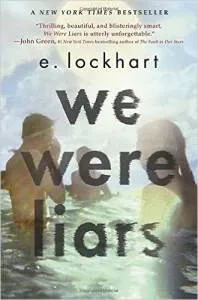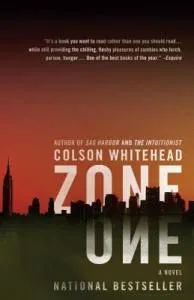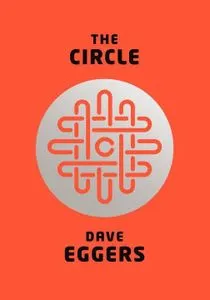
Chapterless Books and How to Put Them Down For a While
This content contains affiliate links. When you buy through these links, we may earn an affiliate commission.
One more chapter. That’s a mantra book lovers might be a little familiar with. Whenever I sit with my latest novel find, I’m ready to read for hours and forget about the bills and the laundry, but those chores don’t forget me, so I have to have some sort of time limit. And then I say to myself, “Okay, but only one more chapter.” And then there’s that feeling of accomplishment—“I’ve read another chapter!”
Then this happens: There are some sneaky books afoot that don’t offer you that peace-of-mind okay-I-can-stop-here-for-now opportunity. Some books simply don’t break, which can lead to finishing an entire book in one sitting. Certainly, that’s not unheard of or even frowned upon, but sometimes that book is 630 pages long. That’s one long sitting, and the plants need to be watered.
 we were liars by E. Lockhart teeters on the divide between having chapters and being chapter-less, which may seem impossible but isn’t. It has numbered chapters, but the chapters don’t page break. They continue right on the same page, which is almost like not having a break. The young adult narrative is speckled with passages that break down into poetry and drive forward a devastatingly peculiar teen world.
Page count: 256
Suggested Break Time: Don’t. It’s too good to put down so read it straight through, weird chapter non-breaks and all—each moment brings all the feelings all at once. But if you must, then break at the numbers.
we were liars by E. Lockhart teeters on the divide between having chapters and being chapter-less, which may seem impossible but isn’t. It has numbered chapters, but the chapters don’t page break. They continue right on the same page, which is almost like not having a break. The young adult narrative is speckled with passages that break down into poetry and drive forward a devastatingly peculiar teen world.
Page count: 256
Suggested Break Time: Don’t. It’s too good to put down so read it straight through, weird chapter non-breaks and all—each moment brings all the feelings all at once. But if you must, then break at the numbers.
 Split into only three sections with no chapters, Zone One by Colson Whitehead takes us into the world of hunting and killing the living dead after they’ve seemed to take over a now-abandoned city. The hunt is continuous, complete with flashback after flashback, which means the narrative can be difficult to break from. The pace of the apocalypse is surprisingly slow, so the intrigue of “what exactly is going to happen when?” lingers page after haunting page.
Page count: 336.
Suggested Break Time: At the sections.
Split into only three sections with no chapters, Zone One by Colson Whitehead takes us into the world of hunting and killing the living dead after they’ve seemed to take over a now-abandoned city. The hunt is continuous, complete with flashback after flashback, which means the narrative can be difficult to break from. The pace of the apocalypse is surprisingly slow, so the intrigue of “what exactly is going to happen when?” lingers page after haunting page.
Page count: 336.
Suggested Break Time: At the sections.
 Still, sections aren’t the same as chapters. Chip Kidd’s The Learners kindly offers sections labeled by time. Great! That first section is only three pages. Doable! The second section is over a hundred. So not only are there no small chapters, the sections are all unbalanced (which really gets the Virgo in me riled up). The plot is completely different from any other novel out there. You’ll learn a little about history, morality, the advertising business, and most of all, font. I’d never even thought about whether or not I’d think a novel about font would be intriguing, or even exist—but it does and it is!
Page count: 258
Suggested Break Time: Read the first section and half the second. Then read the rest of the sections half by half.
Still, sections aren’t the same as chapters. Chip Kidd’s The Learners kindly offers sections labeled by time. Great! That first section is only three pages. Doable! The second section is over a hundred. So not only are there no small chapters, the sections are all unbalanced (which really gets the Virgo in me riled up). The plot is completely different from any other novel out there. You’ll learn a little about history, morality, the advertising business, and most of all, font. I’d never even thought about whether or not I’d think a novel about font would be intriguing, or even exist—but it does and it is!
Page count: 258
Suggested Break Time: Read the first section and half the second. Then read the rest of the sections half by half.
 Remember that 630 page count? Enter Dave Eggers’s The Circle. All those pages and no chapters. It offers Book 1 and Book 2, and it offers some white space to show a pause or switch in time or scene. It also offers tricky discomfort in the form of too-close-to-home social media obsessions, which means putting the book down proves to be really difficult (I literally carried a hard cover copy around with me so I could read for even minutes at a time, which doubled as a workout!).
Page count: as aforementioned, 630
Suggested Break Time: If you have two entire days and read rather quickly, then Day One, Book One; Day Two, Book Two. If you don’t have that kind of spare reading time, then do some math—figure out how long you want to take to read the book and divide the pages by the number of days and hours.
Then write a very strong letter to writers at large asking them to do the math for us next time.
Remember that 630 page count? Enter Dave Eggers’s The Circle. All those pages and no chapters. It offers Book 1 and Book 2, and it offers some white space to show a pause or switch in time or scene. It also offers tricky discomfort in the form of too-close-to-home social media obsessions, which means putting the book down proves to be really difficult (I literally carried a hard cover copy around with me so I could read for even minutes at a time, which doubled as a workout!).
Page count: as aforementioned, 630
Suggested Break Time: If you have two entire days and read rather quickly, then Day One, Book One; Day Two, Book Two. If you don’t have that kind of spare reading time, then do some math—figure out how long you want to take to read the book and divide the pages by the number of days and hours.
Then write a very strong letter to writers at large asking them to do the math for us next time.
 we were liars by E. Lockhart teeters on the divide between having chapters and being chapter-less, which may seem impossible but isn’t. It has numbered chapters, but the chapters don’t page break. They continue right on the same page, which is almost like not having a break. The young adult narrative is speckled with passages that break down into poetry and drive forward a devastatingly peculiar teen world.
Page count: 256
Suggested Break Time: Don’t. It’s too good to put down so read it straight through, weird chapter non-breaks and all—each moment brings all the feelings all at once. But if you must, then break at the numbers.
we were liars by E. Lockhart teeters on the divide between having chapters and being chapter-less, which may seem impossible but isn’t. It has numbered chapters, but the chapters don’t page break. They continue right on the same page, which is almost like not having a break. The young adult narrative is speckled with passages that break down into poetry and drive forward a devastatingly peculiar teen world.
Page count: 256
Suggested Break Time: Don’t. It’s too good to put down so read it straight through, weird chapter non-breaks and all—each moment brings all the feelings all at once. But if you must, then break at the numbers.
 Split into only three sections with no chapters, Zone One by Colson Whitehead takes us into the world of hunting and killing the living dead after they’ve seemed to take over a now-abandoned city. The hunt is continuous, complete with flashback after flashback, which means the narrative can be difficult to break from. The pace of the apocalypse is surprisingly slow, so the intrigue of “what exactly is going to happen when?” lingers page after haunting page.
Page count: 336.
Suggested Break Time: At the sections.
Split into only three sections with no chapters, Zone One by Colson Whitehead takes us into the world of hunting and killing the living dead after they’ve seemed to take over a now-abandoned city. The hunt is continuous, complete with flashback after flashback, which means the narrative can be difficult to break from. The pace of the apocalypse is surprisingly slow, so the intrigue of “what exactly is going to happen when?” lingers page after haunting page.
Page count: 336.
Suggested Break Time: At the sections.
 Still, sections aren’t the same as chapters. Chip Kidd’s The Learners kindly offers sections labeled by time. Great! That first section is only three pages. Doable! The second section is over a hundred. So not only are there no small chapters, the sections are all unbalanced (which really gets the Virgo in me riled up). The plot is completely different from any other novel out there. You’ll learn a little about history, morality, the advertising business, and most of all, font. I’d never even thought about whether or not I’d think a novel about font would be intriguing, or even exist—but it does and it is!
Page count: 258
Suggested Break Time: Read the first section and half the second. Then read the rest of the sections half by half.
Still, sections aren’t the same as chapters. Chip Kidd’s The Learners kindly offers sections labeled by time. Great! That first section is only three pages. Doable! The second section is over a hundred. So not only are there no small chapters, the sections are all unbalanced (which really gets the Virgo in me riled up). The plot is completely different from any other novel out there. You’ll learn a little about history, morality, the advertising business, and most of all, font. I’d never even thought about whether or not I’d think a novel about font would be intriguing, or even exist—but it does and it is!
Page count: 258
Suggested Break Time: Read the first section and half the second. Then read the rest of the sections half by half.
 Remember that 630 page count? Enter Dave Eggers’s The Circle. All those pages and no chapters. It offers Book 1 and Book 2, and it offers some white space to show a pause or switch in time or scene. It also offers tricky discomfort in the form of too-close-to-home social media obsessions, which means putting the book down proves to be really difficult (I literally carried a hard cover copy around with me so I could read for even minutes at a time, which doubled as a workout!).
Page count: as aforementioned, 630
Suggested Break Time: If you have two entire days and read rather quickly, then Day One, Book One; Day Two, Book Two. If you don’t have that kind of spare reading time, then do some math—figure out how long you want to take to read the book and divide the pages by the number of days and hours.
Then write a very strong letter to writers at large asking them to do the math for us next time.
Remember that 630 page count? Enter Dave Eggers’s The Circle. All those pages and no chapters. It offers Book 1 and Book 2, and it offers some white space to show a pause or switch in time or scene. It also offers tricky discomfort in the form of too-close-to-home social media obsessions, which means putting the book down proves to be really difficult (I literally carried a hard cover copy around with me so I could read for even minutes at a time, which doubled as a workout!).
Page count: as aforementioned, 630
Suggested Break Time: If you have two entire days and read rather quickly, then Day One, Book One; Day Two, Book Two. If you don’t have that kind of spare reading time, then do some math—figure out how long you want to take to read the book and divide the pages by the number of days and hours.
Then write a very strong letter to writers at large asking them to do the math for us next time.











